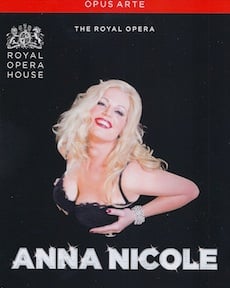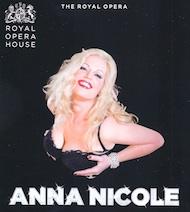
When Mark-Anthony Turnage’s opera Anna Nicole, to a libretto by Richard Thomas, premiered at the Royal Opera House Covent Garden last February, the entire opera world was watching. Watching more than listening, perhaps, given the sex-sational nature of the subject matter, a prurient sojourn into the land of post-Salome operatic titillation.
While the opera is still warm in the can, so to speak, Opus Arte’s Royal Opera House imprint has issued it on DVD and Blu-ray. The advisory warning on the back cover, which states “Contains explicit language and scenes of a sexual nature,” only begins to tell the tale. But that tale is equally spiced with sex, exploitation, and tragedy, all hyped to operatic levels, of course — as if it were possible to hype Anna Nicole Smith’s 40 years on planet Earth anymore than she did herself.
For readers like me, who don’t follow the comings and goings of media-manufactured celebrities of little substance, Anna Nicole Smith, Playboy’s 1993 Playmate of the Year, was born in 1967 in Texas. Thanks to silicone breast implants, the former Wal-Mart employee and waitress moved on from her work as a stripper and lap dancer to glamour girl.
The Act 1 scene in the plastic surgeon's office, with four miserable, modestly endowed women praying that big breasts will cure all their ills, is more than worth the price of admission. So are all the other over-the-top scenes (which means almost everything in the first act). For a hint, check out the "Featured Video" that accompanies this review.
Featured Video
Anna Nicole was married in 1994, at age 26, to an 89-year-old oil tycoon, J. Howard Marshall II. Marshall’s death 13 months later began a decade-long fight over who would inherit his money. That painful decade culminated first in the drug-induced death of Smith’s beloved son, Danny, and then the drugged-out death of Smith herself. (In the opera’s second act you’ll hear the names of more drugs than you knew existed.) In between came weight gain and loss, an infant daughter whose fathership was hotly contested, and more media appearances.
Act 1 of the opera presents one high-powered, four-letter explosion after another — Richard Thomas, after all, also wrote the libretto to Jerry Springer: The Opera — which the music dutifully underlines with far too many similarly emphatic and explosive exclamation points. Act 2 presents a far more musically nuanced portrayal of Smith in decline. Indeed, the second act is so sobering, tragic, and moving that it helps put the super-octane overdrive of the first act in perspective.
At the opera’s center stands the incredible singing and acting of Eva-Maria Westbroek. Managing to replace her native Dutch accent with Anna Nicole’s 100-percent Texan, Westbroek is absolutely sensational on every level. Her Sieglinde in San Francisco Opera’s recent Die Walküre only hinted at her dramatic and vocal abilities.
Equally intense are Susan Bickley as Anna Nicole’s mother and Alan Oke as Marshall. Gerald Finley acts the part of Anna Nicole’s lawyer-cum-lover very well, though his voice is too urbane. The rest of the cast is excellent. Anthony Pappano conducts — not only the Royal Opera House Orchestra and Chorus, but also a drum, guitar, and bass guitar trio that includes John Paul Jones (fabled bassist of Led Zeppelin).
Anna Nicole may not be the new Madame Butterfly, but its subject matter certainly constitutes a modern-day Lulu of sorts. Prudes should run for cover, ’cause almost everything in this opera is out in the open. Everyone else has gotta see it.

